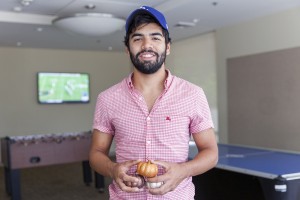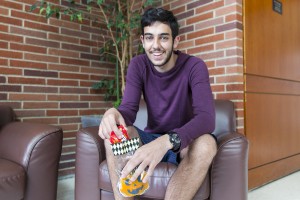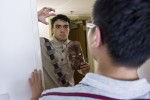October marks the start of the spooky season – costume shops begin to pop up, haunted houses open their doors and festive decorations cover lawns across the country. With so much anticipation surrounding Halloween at UCLA, it is easy to forget that not every country in the world shares the hype.
At UCLA, 12.6 percent of the undergraduate student body hail from more than 50 countries around the world. For many first-years, this October will mark the first time they celebrate Halloween in the United States.
Some international students, including first-year political science student Pablo Donado, experienced Halloween in their home country before coming to campus. Halloween is not a big celebration in Donado’s home country of Colombia, but American influence has increased the prevalence of the holiday, he said.

“It’s pretty close to what we actually get to see in the movies or TV shows because it’s an attempt to try and follow the American model of the celebration,” Donado said.
International celebrations have adapted Halloween specifically to the culture of the country, Donado said. For example, Colombian popular culture influences the types of costumes worn on Halloween. In Colombia, people often dress up as national celebrities, such as Colombian football player James Rodriguez, he said. People also dress up as prominent figures in politics, such as Venezuelan president Nicolas Maduro, to make a political statement.
First-year undeclared humanities student Sean Fontaine said Halloween is widely celebrated in his hometown of Hong Kong due to the international nature of the city. His family celebrates the holiday because his mother is American-born and kept the Halloween tradition alive in his family.
“In Hong Kong, we do have a fair bit of trick-or-treating,” Fontaine said. “Lots of people also make an effort to decorate their houses, to have some new lighting or to just kind of spook stuff up.”
Some students experienced a degree of culture shock when celebrating Halloween for the first time in the United States, including third-year Chinese and political science student Sun Varunpaijit. After arriving at UCLA from Thailand, Varunpaijit was surprised by the costumes some people wore when he visited a street in Hollywood during Halloween his freshman year.
“They wear crazy stuff – like, some people went naked,” Varunpaijit said. “You wouldn’t see these things in my country.”
Despite celebrating back home, Fontaine also said that Halloween is still a much bigger deal in the United States than in Hong Kong. The first thing he saw when visiting Westwood’s Target was the store’s Halloween display, featuring a giant skeleton for sale. He said he was impressed with the amount and variety of activities available to Halloween-lovers, especially the wide variety of haunted houses, mazes and escape rooms.
Celebrating Halloween was not entirely new to some international students, like first-year applied mathematics student Anoushka Gupta from India. While not as prevalent, Halloween was observed through some festivities in her neighborhood, she said.
“There’d be Halloween parties, there’d be a few kids who would go trick-or treating, but it’s not that big of a deal yet,” Gupta said.
Although she’s been to a few parties, Gupta is most excited to finally try out a Halloween tradition in Westwood she’s never been able to participate in before – trick-or-treating.
“We never actually got to do it on a serious scale,” she said. “My friend and I … we’re just going to dress up, go into residential areas and pretend to be kids and go trick-or-treating, just so we can do it – I’m actually quite excited.”
First-year economics student Arthur Costa also found the idea of trick-or-treating appealing, particularly because of the lack of suburbs in his native country Brazil.

“I’m more interested in the candy side of Halloween,” Costa said. “Just going around houses and asking for candy, because I’ve never done that in my whole life; It’s like a myth in Brazil.”
Many of the students made plans to take advantage of the Halloween-themed attractions around Los Angeles. Varunpaijit hopes to try LA’s infamous Haunted Hayride at Griffith Park. After some local costume shopping, Fontaine is excited to dress up in one of the many Star Wars masks he purchased from Target. Costa wants to visit UCLA’s surrounding neighborhoods in Beverly Hills and West Hollywood to check out Halloween decorations, which he said he hopes will be similar to the ones he’s seen in movies.
Similarly, Donado made plans to attend Halloween parties with some of his international friends to share the new experience together.
“It’s about getting to know the experience of the American Halloween with them, people that are in the same situation as I am, in cultural terms,” Donado said. “I’m looking forward to that, getting to know with them what Halloween is from an American perspective.”

Participating in our holidays and celebrations is yet another way to enhance their assimilation of our culture. Being an international student isn’t easy, given our complex culture and language. Assistance must come from numerous sources to aid these young people embarking on life’s journey. Most struggle in their efforts and need guidance from schools’ international departments, immigration protection, host families, concerned neighbors and fellow students, and even informative books to extend a cultural helping hand so we all have a win-win situation.
One such new award-winning worldwide book/ebook that reaches out to help anyone coming to the US is “What Foreigners Need To Know About America From A To Z: How to Understand Crazy American Culture, People, Government, Business, Language and More.” It is used in foreign Fulbright student programs and endorsed worldwide by ambassadors, educators, and editors. It also identifies “foreigners” who became successful in the US and how they’ve contributed to our society, including students.
A chapter on education explains how to be accepted to an American university and cope with a confusing new culture, friendship process and daunting classroom differences. Some stay after graduation. It has chapters that explain how US businesses operate and how to get a job (which differs from most countries), a must for those who want to work with/for an American firm here or overseas.
It also has chapters that identify the most common English grammar and speech problems foreigners have and tips for easily overcoming them, the number one stumbling block they say they have to succeeding here.
Good luck to all at UCLA or wherever you study!